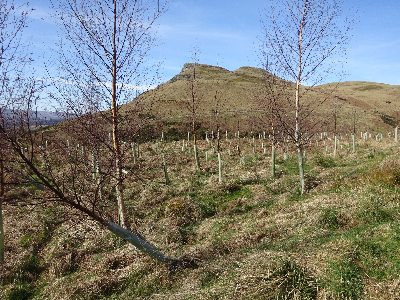Friday 27th August 2021, 12:03pm

Over the last couple of months, Access & Conservation Officer Davie Black has been busy on a range of matters, including the controversial decision by Network Rail to close the much-used Dalwhinnie level crossing, and access problems in Glen Lyon and Reiff.
These issues are well-known via social media and, in the case of Dalwhinnie, the mainstream media too.
But there’s a lot of work Davie has been doing which doesn’t make the headlines. And some of that is catching potential access problems before they arise, in the planning stage. Often they relate to forestry operations but windfarm and hydro schemes can also be included.
Davie explains some of his work over the last months:
In forestry planning we looked at two proposals for restructuring existing forests, at Glen Doll and at Corrour. Doll was mainly softwood replanting, with the existing access routes maintained to Dreish and Mayar, and for the climbing crags on the southern side of the glen. Corrour Forest was undergoing a radical change to include many more sparsely planted native broadleaved trees, potentially opening up more access through the plantation to the open hill, with the welcome intention to do it without internal deer fences. The main deer fence on the southern edge would remain for the time being, and access points were assured.
Three new native woodland proposals were assessed. At Auch Estate at Bridge of Orchy, the intention is to restore tree cover to the slopes of Beinn a Chaiseil and Beinn nam Fuaran. A Strava heat map of the location showed many more informal routes taken by walkers than the traditional routes shown in guidebooks – the consultant was informed of this and requested to provide access points where people actually do take access, and to keep wide gaps in planting to allow for getting up and down the hillside.
The next two proposals on Speyside illustrate the subtleties of how new woodlands can be created. The Lost Forest proposal for Kinrara Estate is a proposal to convert a former grouse shooting estate into a broadleaved woodland by planting trees, and the Abernethy National Nature reserve proposal is a plan to jump-start woodland expansion by selective tree-planting and ground disturbance and seed sowing. The challenge for both is in wild deer being quite partial to small trees.
The difference lies in the Lost Forest intending to buy in commercial nursery-grown trees to plant, and protect them by putting extensive deer fences around the area. Abernethy’s plans were to gather seed from existing trees on the estate, to grow and sow, then plant out in small clumps, with no deer fences, deer being managed by culling. Both will store carbon away; the question is which method is better for wildlife? No fences are definitely better for recreational access!
A new pumped storage hydro scheme in being proposed for the wild countryside to the south of Loch Ericht – Corrievarkie. Still at an early scoping stage, Mountaineering Scotland sent in comments on what would be suitable viewpoints to assess it from a mountaineering perspective.
Read our hydropower position statement
5 windfarm proposals, all at an early scoping stage, 3 of which are of little mountaineering interest. Two will require careful assessment if they make it to a full application - Bunloinn, west of Loch Loyne, and Rivox, by the South Lowther Hills, near Moffat.
Read our windfarms position statement
All our responses to planning applications and consultation can be viewed on our planning and consultation webpage.